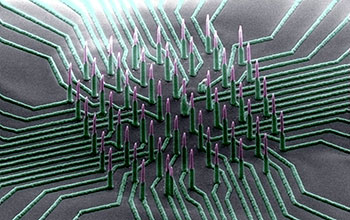Multimedia Gallery
Colorized SEM image of a nanowire array
A colorized scanning electron microscope image of a nanowire array that can record the electrical activity of neurons in fine detail.
More about this image
A research team led by engineers at the University of California, San Diego, has developed nanowires that can record the electrical activity of neurons in fine detail. The technology could have future applications as a platform to screen drugs for neurological diseases and could enable researchers to better understand how single cells communicate in large neuronal networks.
The current measuring technique used by researchers to obtain information about a neuron's health, activity and response to drugs is sensitive to small potential changes and provides readings with high, signal-to-noise ratios. The method can be destructive, breaking the cell membrane and eventually killing the cell. It is also limited to analyzing only one cell at a time, making it impractical for studying large networks of neurons, which are how they are naturally arranged in the body.
The nanowire technology developed in the lab of UC San Diego's Shadi Dayeh, an electrical engineering professor at the Jacobs School of Engineering and the team’s lead investigator, is nondestructive and can simultaneously measure potential changes in multiple neurons -- with the high sensitivity and resolution achieved by current state-of-the-art.
The device consists of an array of silicon nanowires densely packed on a small chip patterned with nickel electrode leads that are coated with silica. The nanowires poke inside cells without damaging them and are sensitive enough to measure small potential changes that are a fraction of or a few millivolts in magnitude. Researchers used the nanowires to record the electrical activity of neurons that were isolated from mice and derived from human-induced pluripotent stem cells. These neurons survived and continued functioning for at least six weeks while interfaced with the nanowire array in vitro.
"We envision that this nanowire technology could be used on stem cell-derived brain models to identify the most effective drugs for neurological diseases," said Anne Bang, director of cell biology at the Conrad Prebys Center for Chemical Genomics at the Sanford Burnham Medical Research Institute, whose lab was part of the collaborative team.
This research was supported by a U.S. National Science Foundation Faculty Early Career Development (CAREER) award (grant ECCS 1351980). Some student support for particular aspects of the work was funded by NSF grant DMR 1503595.
To learn more about this research, see the NSF News From the Field story 'Neuron-reading' nanowires could accelerate development of drugs for neurological disease. (Date image taken: January 2014; date originally posted to NSF Multimedia Gallery: Nov. 28, 2017)
Credit: Integrated Electronics and Biointerfaces Laboratory, UC San Diego
See other images like this on your iPhone or iPad download NSF Science Zone on the Apple App Store.
Images and other media in the National Science Foundation Multimedia Gallery are available for use in print and electronic material by NSF employees, members of the media, university staff, teachers and the general public. All media in the gallery are intended for personal, educational and nonprofit/non-commercial use only.
Images credited to the National Science Foundation, a federal agency, are in the public domain. The images were created by employees of the United States Government as part of their official duties or prepared by contractors as "works for hire" for NSF. You may freely use NSF-credited images and, at your discretion, credit NSF with a "Courtesy: National Science Foundation" notation.
Additional information about general usage can be found in Conditions.
Also Available:
Download the high-resolution JPG version of the image. (634.4 KB)
Use your mouse to right-click (Mac users may need to Ctrl-click) the link above and choose the option that will save the file or target to your computer.

 All images in this series
All images in this series